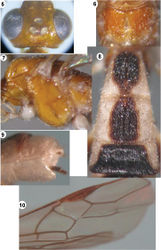Iporhogas albilateralis
| Notice: | This page is derived from the original publication listed below, whose author(s) should always be credited. Further contributors may edit and improve the content of this page and, consequently, need to be credited as well (see page history). Any assessment of factual correctness requires a careful review of the original article as well as of subsequent contributions.
If you are uncertain whether your planned contribution is correct or not, we suggest that you use the associated discussion page instead of editing the page directly. This page should be cited as follows (rationale):
Citation formats to copy and paste
BibTeX: @article{Long2014ZooKeys428, RIS/ Endnote: TY - JOUR Wikipedia/ Citizendium: <ref name="Long2014ZooKeys428">{{Citation See also the citation download page at the journal. |
Ordo: Hymenoptera
Familia: Braconidae
Genus: Iporhogas
Name
Iporhogas albilateralis Long, 2014 sp. n. – Wikispecies link – ZooBank link – Pensoft Profile
Material
Holotype, female (VNMN), ‘Rog.608’, “[NE Vietnam:] Vinh Phuc, Tam Dao NP, 110m, bushes, 06.x.2008, KD Long”. Paratypes; 1 female (VNMN), ‘Rog.224’, “[S Vietnam:] Kien Giang, Phu Quoc island, garden, 21.vii.2002, KD Long”; 1 female (RMNH), ‘Rog.282’, “ [NW Vietnam:] Hoa Binh, Yen Thuy, fruit orchard, MT, 01-10.ix.2002, KD Long”.
Description
Holotype, female, body length 6.1 mm, fore wing length 4.6 mm (Fig. 1).
Head. Antenna broken, with 35 segments remaining; middle segments 3.0 times longer than wide (6:2); third antennal segment 1.1 times fourth segment (9:8); width of face equal to length of face and clypeus combined; malar space 1.2 times as long as mandible width (6:5); mandible width 0.7 times as long as hypoclypeal depression (5:7); in dorsal view height of eye 3.2 times as long as temple (16:5); occipital carina weakly concave (Fig. 5); in lateral view, width of eye 3.0 times as long as temple (15:5); ocelli large, POL:Od:OOL=2:5:4; distance between anterior and posterior ocelli 0.75 times as long as OOL (3:4) (Fig. 5); face rugose-punctate with circular fine striae around antennal socket; frons shiny, finely rugose; temple smooth; vertex shiny with fine curved striae (Fig. 5).
Mesosoma. Length of mesosoma 1.45 times as long as high (70:48); propleuron wide and deep, crenulated anteriorly (Fig. 7); mesoscutum shiny with sparse fine punctures; notauli deep, crenulated anteriorly, smooth posteriorly; scutellar sulcus 0.4 times as long as scutellum (5:12) with one medial carina; scutellum shiny, smooth; precoxal sulcus shallow, punctate; mesopleuron shiny, largely smooth medially (Fig. 7), anterior area of mesopleuron and mesosternum with sparse fine punctures; metapleuron punctate; propodeum areolate medially, punctate basally, rugose apically (Fig. 6).
Wings. Fore wing: pterostigma 3.8 times as long as wide (38:10); r:2-SR:3-SR:SR1=7:13:20:34; vein r arising from middle of pterostigma; vein 1-SR+M distinctly S-shaped; vein cu-a vertical, postfurcal; vein 1-CU1 near subquadrate (Fig. 10), 1-CU1:cu-a:2-CU1 =2:7:23; basal length of second submarginal 2.5 times as long as its apical width (32:13). Hind wing: vein M+CU 1.2 times as long as vein 1-M; M+CU:1-M: 1r-m=28:24:13; vein 2-SC+R transverse.
Legs. Hind coxa shiny, with oblique fine striae dorso-apically; length of hind femur, tibia and basitarsus 4.8, 9.0 and 9.0 times as long as their width, respectively; inner hind tibial spur 0.4 times as long as basitarsus (14:36); hind tarsal claw with large lobe.
Metasoma. First tergite 1.1 times as long as its apical width (33:31) (Fig. 8); medially second tergite 1.5 times longer than third tergite (30:20); second suture wide, crenulate; first and second tergites with medial longitudinal carina; third-fifth tergites with dense parallel striae on whole surface; ovipositor sheath 0.75 times as long as hind basitarsus (9:12); ovipositor sheath straight (Fig. 9).
Colour. Body bicoloured; scapus yellow; antennal segments brownish yellow; palpi pale yellow; fore and middle legs yellow; hind coxa black, yellow basally; hind trochanter and trochantellus white; hind femur black, white basally; hind tibia yellowish brown basally, darkish apically; hind tarsus brown; pterostigma and vein yellowish brown; propodeum brownish yellow; first-second metasomal tergites black medially, white laterally; third-fifth tergites largely black medially, white baso-laterally; sixth tergite white entirely; sternites ivory.
Variation
Paratypes with 54 antennal segments; first tergite 1.1–1.25 times as long as apical width; medial length of metasomal second tergite 1.5 times as long as third tergite medially; body length 6.2–6.5 mm; fore wing length 4.7–4.8 mm.
Male
Unknown.
Distribution
NE Vietnam: Vinh Phuc; NW Vietnam: Hoa Binh; S Vietnam: Phu Quoc Island.
Biology
Unknown.
Etymology
From “albus” (Latin for “white”) and “lateralis” (Latin for “of the side”), because of the white lateral side of the metasoma.
Notes
Iporhogas albilateralis sp. n. can be distinguished from other species by having the hind coxa with oblique striae dorso-apically. The new species differs from Iporhogas chinensis Chen & He, 1997, from China by having the precoxal sulcus shallow, punctate; mesopleuron finely and sparsely punctate; metapleuron punctate and vein cu-a of fore wing distinctly postfurcal. The new species also differs from Iporhogas flavistigma Chen & He, 1997, from China by having the occipital carina in dorsal view roundly concave; precoxal sulcus shallow, sparsely punctate; metapleuron largely punctate and vein M+CU of hind wing slightly longer vein 1-M.
Original Description
- Long, K; 2014: New records of the genus Iporhogas Granger (Hymenoptera, Braconidae, Rogadinae) from Vietnam, with description of four new species ZooKeys, 428: 79-96. doi
Images
|

